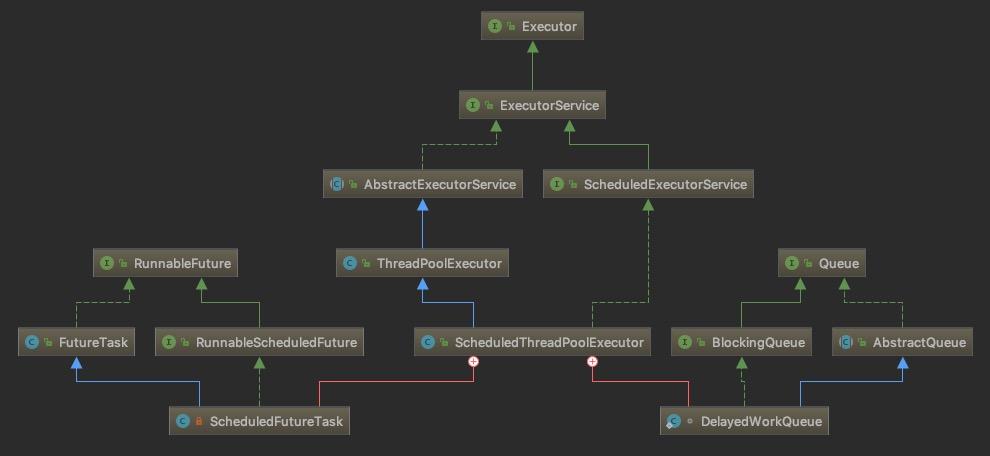Java并发——ScheduledThreadPoolExecutor分析

从图中我们可以看到ScheduledThreadPoolExecutor继承ThreadPoolExecutor实现了ScheduledExecutorService接口。它相当于提供了"延迟"和"周期执行"功能的ThreadPoolExecutor,还有两个重要内部类 DelayedWorkQueue 和 ScheduledFutureTask
构造方法
public ScheduledThreadPoolExecutor(int corePoolSize) {
super(corePoolSize, Integer.MAX_VALUE, 0, NANOSECONDS,
new DelayedWorkQueue());
}
public ScheduledThreadPoolExecutor(int corePoolSize,
ThreadFactory threadFactory) {
super(corePoolSize, Integer.MAX_VALUE, 0, NANOSECONDS,
new DelayedWorkQueue(), threadFactory);
}
public ScheduledThreadPoolExecutor(int corePoolSize,
RejectedExecutionHandler handler) {
super(corePoolSize, Integer.MAX_VALUE, 0, NANOSECONDS,
new DelayedWorkQueue(), handler);
}
public ScheduledThreadPoolExecutor(int corePoolSize,
ThreadFactory threadFactory,
RejectedExecutionHandler handler) {
super(corePoolSize, Integer.MAX_VALUE, 0, NANOSECONDS,
new DelayedWorkQueue(), threadFactory, handler);
}
复制代码
因为其继承了ThreadPoolExecutor,调用了ThreadLocalExecutor的构造方法。当核心线程数达到 corePoolSize ,会将任务提交给 有界阻塞队列 DelayedWorkQueue。ScheduledThreadPoolExecutor线程池最大线程数为 Integer.MAX_VALUE
主要方法
ScheduledThreadPoolExecutor实现了ScheduledExecutorService接口,该接口提供了如下方法:
// 在给定延迟后,执行Runnable任务
public ScheduledFuture schedule(Runnable command,
long delay, TimeUnit unit);
// 在给定延迟后,执行Callable任务
public ScheduledFuture schedule(Callable callable,
long delay, TimeUnit unit);
// 给定延迟(initialDelay)之后,随后以给定时间(period)为周期执行任务
// 即执行将在initialDelay之后开始,然后是initialDelay+period,
// 再是initialDelay + 2*period,依此类推
// 如果上一个任务没有执行完毕,则需要等上一个任务执行完毕后立即执行
public ScheduledFuture scheduleAtFixedRate(Runnable command,
long initialDelay,
long period,
TimeUnit unit);
// 创建并执行在给定的初始延迟(initialDelay)之后首先启用的定期操作
// 随后每个任务执行的终止和下一个执行的开始之间给定的延迟(delay)
public ScheduledFuture scheduleWithFixedDelay(Runnable command,
long initialDelay,
long delay,
TimeUnit unit);
复制代码
第一、第二个schedule方法都是 一次性操作 只不过入参一个是Runnable,一个是callable
scheduleAtFixedRate、scheduleWithFixedDelay方法可以看如下示例
public static void main(String[] args) {
SimpleDateFormat sdf = new SimpleDateFormat("hh:MM:ss");
ScheduledExecutorService executorService = Executors.newScheduledThreadPool(2);
Runnable task1 = () -> {
try {
Thread.sleep(3000);
} catch (InterruptedException e) {
e.printStackTrace();
}
System.out.println(Thread.currentThread().getName() + "测试" + sdf.format(new Date()));
};
Runnable task2 = () -> {
try {
Thread.sleep(3000);
} catch (InterruptedException e) {
e.printStackTrace();
}
System.out.println(Thread.currentThread().getName() + "测试" + sdf.format(new Date()));
};
executorService.scheduleAtFixedRate(task1, 0, 2, TimeUnit.SECONDS);
executorService.scheduleWithFixedDelay(task2, 0, 2, TimeUnit.SECONDS);
}
输出:
pool-1-thread-1测试11:12:37
pool-1-thread-2测试11:12:37
pool-1-thread-1测试11:12:40
pool-1-thread-2测试11:12:42
pool-1-thread-1测试11:12:43
pool-1-thread-1测试11:12:46
pool-1-thread-2测试11:12:47
复制代码
周期间隔2秒,任务耗时3秒
scheduleAtFixedRate方法:
1.若任务耗时超过周期间隔,则需要等待上个任务完成下个任务才能执行
2.若任务耗时小于周期间隔,则下个任务按周期间隔执行任务
scheduleWithFixedDelay方法:
1.下任务等到上个任务执行完成+周期间隔之后才执行任务
逻辑处理相差不多,以schedule方法为例分析
public ScheduledFuture schedule(Callable callable,
long delay,
TimeUnit unit) {
if (callable == null || unit == null)
throw new NullPointerException();
RunnableScheduledFuture t = decorateTask(callable,
new ScheduledFutureTask(callable,
triggerTime(delay, unit)));
delayedExecute(t);
return t;
}
复制代码 先参数校验,再构造task,最后调用delayedExecute()方法延迟执行任务
private void delayedExecute(RunnableScheduledFuture task) {
// 判断线程池是否处于RUNNING状态,不处于则根据相应拒绝策略拒绝任务
if (isShutdown())
reject(task);
else {
// 往阻塞队列中添加任务
super.getQueue().add(task);
if (isShutdown() &&
!canRunInCurrentRunState(task.isPeriodic()) &&
remove(task))
task.cancel(false);
else
ensurePrestart();
}
} void ensurePrestart() {
int wc = workerCountOf(ctl.get());
if (wc < corePoolSize)
addWorker(null, true);
else if (wc == 0)
addWorker(null, false);
}
复制代码 复制代码
复制代码
1.循环CAS将线程池中的线程数加一
2.新建一个线程并启用
当线程执行任务,都会调用到任务的run()方法
public void run() {
// 判断是否是周期任务
boolean periodic = isPeriodic();
// 判断当前线程状态是否能执行任务
if (!canRunInCurrentRunState(periodic))
cancel(false);
// 不是周期性任务,直接执行任务
else if (!periodic)
ScheduledFutureTask.super.run();
// 若是周期性任务,设置下次执行任务的时间
else if (ScheduledFutureTask.super.runAndReset()) {
// 设置任务下次执行时间
setNextRunTime();
// 将下次任务往阻塞队列中添加
reExecutePeriodic(outerTask);
}
}
复制代码 1.先判断该任务是否可以执行,若不能执行则调用cancel方法取消
2.再判断是否是周期性任务,若不是直接执行
3.最后调用runAndReset方法执行任务并重置,setNextRunTime方法设置任务下次的执行时间,reExecutePeriodic方法重新把任务添加到队列中.
private void setNextRunTime() {
long p = period;
if (p > 0)
time += p;
else
time = triggerTime(-p);
}
void reExecutePeriodic(RunnableScheduledFuture task) {
if (canRunInCurrentRunState(true)) {
super.getQueue().add(task);
if (!canRunInCurrentRunState(true) && remove(task))
task.cancel(false);
else
ensurePrestart();
}
}
复制代码 DelayedWorkQueue
ScheduledThreadPoolExecutor是把任务添加到DelayedWorkQueue中,它是一个基于堆的数据结构,通过ScheduledFutureTask的compareTo方法比较大小,小的排在前面,大的排在后面
public int compareTo(Delayed other) {
if (other == this) // compare zero if same object
return 0;
if (other instanceof ScheduledFutureTask) {
ScheduledFutureTask x = (ScheduledFutureTask)other;
long diff = time - x.time;
if (diff < 0)
return -1;
else if (diff > 0)
return 1;
else if (sequenceNumber < x.sequenceNumber)
return -1;
else
return 1;
}
long diff = getDelay(NANOSECONDS) - other.getDelay(NANOSECONDS);
return (diff < 0) ? -1 : (diff > 0) ? 1 : 0;
}
复制代码 首先按照time排序,time小的排在前面,大的排在后面,若time相同,则使用sequenceNumber排序,小的排在前面,大的排在后面











![[HBLOG]公众号](https://www.liuhaihua.cn/img/qrcode_gzh.jpg)

